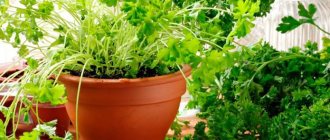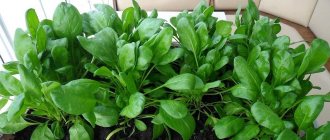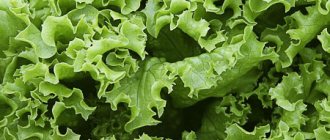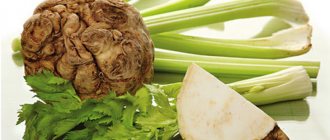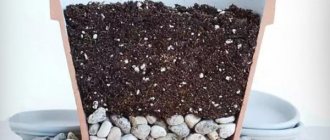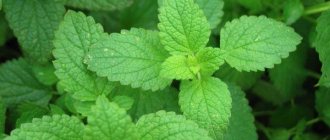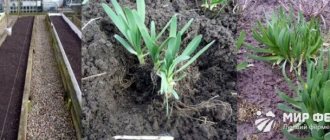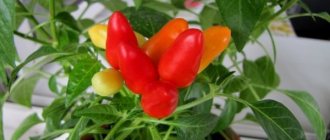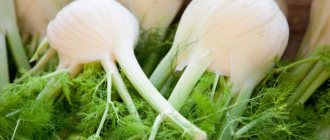Those who want to decorate the New Year's table with “green” vitamins from their own garden bed can do this without much difficulty. All you need to do is plant the desired crop, placing it in flower pots on the windowsill. Thus, you will always receive fresh, vitamin-rich greens and also decorate your interior.
Have time to grow healthy herbs for the holidays
Advice! We choose seeds with early germination.
Spinach
Spinach is one of the most beneficial foods for the human body.
Spinach is one of the most beneficial foods for the human body. It contains the entire complex of vitamins, as well as amino acids, micro- and macroelements.
Ideal for sowing at any time of the year. 40 days after sowing the seeds, you will decorate the holiday table with fresh spinach leaves. You can sow spinach in a container.
Note: Choose a container for sowing with a depth of at least 15 cm.
For cultivation we use ready-made soil (except peat). Before planting, soak the seeds for a day and sow them at a distance of 5 cm from each other, to a depth of 1.5 cm. Water as usual, making sure that the soil does not dry out! We maintain the temperature in the room at 18°C. In cloudy weather, it is advisable to turn on additional lighting using a phytolamp. Gardeners recommend such varieties of spinach as: Gigantic (ripening period 30 days), fat-leaved.
Growing greens can “revive” the interior
Containers for planting herbs and spices
You can use absolutely any containers for planting herbs or spices, from wooden pallets to pots and plastic bowls. The only requirement for containers for growing plants is the presence of drainage holes in the bottom through which excess water will flow out during watering.
Some lovers of homemade greens make their own boxes from spruce boards. It is optimal to make such containers for planting in the following sizes: length - 45 cm, width - 25 cm and height - 13-14 cm. The thickness of the boards themselves should be about 1.5 cm.
Helpful information
Daria Vorontsova
Amateur gardener. He is interested in growing various greens at home.
To make containers for planting, you should not take the remains of furniture boards - in the process of regular watering of plants, the coating of such walls of the box will peel off, and the harmful substances released will get into the soil, and then into the greenery.
Lettuce
Bright and healthy salad
One of the most popular types of salad. Recommended especially for older people. Helps lower blood pressure, helps with respiratory diseases, is eaten for diabetes, and is especially useful for nursing mothers. Seeds are sown to a depth of 1 cm, in a container 15 cm high and covered with film. When shoots appear, remove the film and place the container on the windowsill. After a month, the first harvest is ready for consumption. Watering is done once every two days.
Two weeks after sowing, lettuce leaves are ready for cutting
To grow at home, buy any early-ripening variety of lettuce.
Advice! When using soil from your own garden, do not forget to disinfect it first.
When planting in a container or pot, be sure to provide drainage.
On a note! The daylight hours for an indoor “vegetable garden” should be 10-12 hours. To prolong it, turn on the phytolamp.
Growing parsley from seeds at home
growing parsley from seeds at home
Parsley can be grown at home in two ways. This is sowing seeds into the soil and forcing them out of the roots. The second method requires the preparation of material for planting in the fall. For planting, parsley roots with an apical bud are used. Land for growing parsley can be bought in a store, or you can use garden soil; it should be treated with a solution of potassium permanganate. Plant root vegetables in moist soil in a container or flower pot. If the tops are long, cut them off and sprinkle with soil. This option is the most common among gardeners. You can also grow parsley from seeds. Rinse the seeds with water and wrap in a damp cloth. Prepare the soil; garden soil or store-bought soil will do. The box for parsley should be 20 cm higher than for other greens. Drainage is poured into the bottom of the box, then soil. Water, make grooves and sow seeds, then sprinkle with soil. Water every other day with a spray bottle until shoots appear. After germination, water as needed. This culture is not afraid of cold weather, so it grows well on a windowsill.
Cress growing on a windowsill
The most unpretentious type of greenery for a mini-garden is considered to be watercress. Sow the seeds in a small container of peat soil, 3cm high, and gently press them into the ground. Many people use paper towels or cotton cloth instead of soil. Water and cover with dark film or paper. Place the container with the seeds in a warm place. Temperature for germination is from + 7 to + 15 degrees. When the seeds germinate, remove the film and place the container in a bright place. Do not allow the container to dry out. Cress is a salad ideal for growing on a windowsill.
Growing basil at home
Suitable varieties for growing basil at home, such as: lemon, purple, marquise, clove. Basil seeds, unlike other crops, take a very long time to germinate. In order for the seeds to germinate faster, it is necessary to keep the planting material in a warm place for two weeks, then soak it in warm water. Floating seeds are not suitable for sowing. Garden soil or store-bought soil is suitable. Cover the bottom of the box with expanded clay or drainage, and cover the top with soil. Sow the seeds about 3cm apart. To speed up the germination process, cover the box with film. Maintain temperature 25 degrees. After the basil has sprung, it must be thinned out, leaving 5 cm of free space around the basil. This crop is light-loving, so install a lamp for illumination. Basil requires special care. It needs to be watered and the soil loosened. Apply fertilizers.
Sarepta mustard
Mustard contains a large amount of vitamins and minerals.
This variety of salad mustard, containing a large amount of vitamins and minerals, is considered an unpretentious plant. After sowing, the crop is harvested after 25-30 days. Sarepta mustard “feels” comfortable in the same container with watercress. Requires moderate watering. Feels great with short daylight hours and an air temperature of 16 degrees.
Mustard sprouts
On the windowsill we grow common early ripening varieties - Volnushka, Krasnolistnaya.
What you will need
Greens can be grown on the windowsill all year round, and many try to compensate for vitamin deficiencies with self-grown plants in winter and spring.
Often, beginners give up the idea of a garden bed on a windowsill because they don’t know how to grow greens properly, where to start, and how to care for a mini-garden .
Landing tanks
To plant a home garden, the following are suitable:
- plastic, ceramic flower pots;
- wooden, plastic boxes.
There are a lot of container options; you can use old plastic buckets and even large diameter PVC pipes cut lengthwise.
Soil for planting
Garden stores offer several varieties of ready-made substrates specifically for home gardening. is also suitable , but it is better to add humus and peat to it .
Some craftsmen grow greens on a windowsill without soil, skillfully using hydroponics techniques.
Drainage
Drainage is a necessary measure for gardening on a windowsill. Considering the limited volume of containers where plants are placed, stagnation of water will be destructive.
Therefore, each box and pot must have drainage holes , and expanded clay or broken brick must be laid on the bottom.
Seed preparation
Particular attention should be paid to the choice of seeds - some grow and bear fruit very well in a limited space (for example, there are varieties of indoor tomatoes and cucumbers), and some stretch out and wither due to such conditions.
The seeds should be soaked before sowing; disinfection would also be a good idea, but if there is a mark on the package that the seeds have been pre-treated (granulated), these procedures are not necessary.
Sowing seeds
Usually on the bag of seeds there is a brief instruction , which provides step-by-step recommendations for planting - at what distance from each other to place the seeds and at what depth to plant them.
Arugula
Small pots or containers are suitable for planting arugula.
Arugula is rich in B vitamins, iron, magnesium, and iodine. After sowing the seeds, healthy vitamins will appear on your table within 25 days. The soil should be loose.
Small pots or containers are suitable for planting. Scatter the seeds on the surface, water and sprinkle with 1 cm of soil. Cover the container with film. After 5 days, when the shoots appear, remove the film and place the container on the windowsill. Arugula is a lover of light. If necessary, provide additional lighting.
Why doesn't dill grow at home?
If all the requirements are met, dill will definitely grow. It is advisable to plant late-ripening varieties at home: they will be more useful, they stretch less and produce inflorescences later. Problems with dill at home can arise due to too high a temperature (especially at night), lack of light (lighting is required in the morning and evening) and poor-quality soil (do not buy the cheapest one). You shouldn’t skimp on fertilizing either: the best option is special fertilizing for greens, they are also on sale.
Growing dill on a windowsill is both a hobby and vitamins. The activity is interesting, not very difficult, but requires daily gardening.
Chervil
Chervil resembles parsley leaves
This is an herb that resembles parsley leaves, but with a subtle scent of anise, parsley, celery and mint combined. The leaves and stems contain large amounts of vitamins, minerals, antioxidants and dietary fiber. It is used in dentistry as an antiseptic, helps lower blood sugar, and as an anticancer agent.
Chervil has a subtle aroma of anise, parsley, celery and mint combined
Grows well in high humidity and air temperatures up to 15 degrees. Does not require additional lighting and is not picky about soil composition. When planting in a small container, you will have to dive, so it is better to sow immediately in pots 15 cm high. A month after sowing, it is ready to eat.
Corvel, depending on the variety, is distinguished by the color and shape of the leaves: Openwork, Curly.
What greens grow well on the windowsill?
It should be borne in mind that not every plant can be grown on a windowsill . Thus, difficulties may arise with tall crops. What greens to choose to plant a vegetable garden in your apartment?
Spinach
A source of microelements, very healthy and simply very tasty . It can be added to smoothies and vegetable dishes, used in salads and sandwiches.
To grow it, you will need medium containers with a height of 20–22 cm. All-purpose soil mixed with peat is suitable. The first shoots appear 8–10 days after sowing.
To speed up seed germination, it is recommended to cover the container with cling film. The harvest is harvested after 1.5 months, when the leaves outgrow 8 cm.
Attention! In winter, with short daylight hours, spinach requires additional lighting and air humidification.
Lettuce
A popular leaf crop, rich in trace elements, minerals and B vitamins .
To grow lettuce, you need a fairly deep container (at least 12 cm). You can take ready-made soil, or you can prepare the substrate yourself. For this you will need:
- garden soil - 1 part;
- compost - 1 part;
- peat - 1 part.
To increase the looseness of the finished substrate, sand is added to it.
To increase the germination of seeds, it is recommended to germinate them before planting. The seeds are placed in a damp cloth and left in a dark, warm place.
Important! To organize a continuous cycle of growing lettuce and always have fresh greens on hand, it is recommended to sow the seeds in different boxes with an interval of 14 days.
Watercress
This wonderful cabbage green is tasty (has a specific spicy taste, similar to horseradish), and is rich in nutrients. Watercress is easy to care for and grows well on a windowsill .
To grow you will need:
- not a very deep container (box, pot, plastic container, ceramic cup) about 10 cm deep;
- nutrient substrate (soil, hydrogel or wet wipe);
- timely watering.
Growing watercress is simple; regular watering and sufficient sunlight become the basis of care.
Leaf salad
Leaf varieties of lettuce do well in apartment conditions and grow readily. The shallow root system allows the use of shallow pots for growing herbs, as long as there is good drainage.
Choose a container 10–12 cm deep; a layer of expanded clay must be poured onto the bottom. You can use universal soil.
The seeds do not require special preparation before growing, but if there are no appropriate markings on the packaging, the seeds must be disinfected in a solution of potassium permanganate.
Attention! To increase germination, lettuce seeds are recommended to be soaked before planting.
Arugula
A great option, arugula is easy to grow at home. In addition to its fresh taste, it has a lot of useful substances and high nutritional value .
For growing, you don’t need a deep container; just take a container about 10 cm deep, put drainage on the bottom and fill it with a universal ready-made substrate for seedlings (not for indoor plants!).
For successful growing season, lettuce requires regular fertilizing with potassium-phosphorus complexes, watering and sufficient lighting.
Basil
Another great plant that is easy to grow at home. Basil is unpretentious, has a bright spicy taste that can decorate not only a salad, but also a hot dish, and has a whole range of useful microelements .
You can grow basil bushes all year round. If you plant the seeds in different pots with a short (about 2 weeks) interval, then fresh greens will be on the table all the time.
Attention! You will need a medium-sized pot for the plant with a drainage hole.
You can take ready-made soil (for seedlings), or you can mix a universal substrate with garden soil in a 1:1 ratio.
It is recommended to soak the seeds before planting to increase their germination. Depending on the variety, the first shoots should appear 1–1.5 weeks after planting.
Parsley
Unpretentious, it is an excellent addition to hot and cold dishes. We can talk for a long time about the beneficial properties of parsley; its greens are used not only in cooking and canning, but also in cosmetology .
To grow greens, you will need a fairly large pot or box with sides at least 20 cm high. A drainage layer must be placed on the bottom to remove excess moisture from the roots.
Choose neutral or slightly acidic substrates. Before planting, the seeds need to be soaked - this will increase germination and speed up the emergence of sprouts.
The key to successful cultivation will be a constant temperature: parsley does not tolerate extreme heat or cold. The optimum temperature for growing it is 17…20 °C.
Dill
This fragrant greenery is easy to grow in a regular flower pot, the main thing is to choose a variety that is not too tall .
The optimal volume of the pot is 2 liters, the height of the sides should not be less than 10 cm. Be sure to provide a drainage hole.
The main criterion for choosing soil is the nutrients in the substrate. The soil must be loose and breathable.
It is recommended to disinfect seeds before planting, and to increase germination, they must first be soaked.
Cilantro
This wonderful green, popularly known as “Chinese parsley,” has long been grown both in gardens and on windowsills .
Coriander (the second name for cilantro) is unpretentious. A medium-sized container with a side height of at least 10 cm is suitable for it. A nutritious substrate, regular watering, a sufficient amount of sunlight - and fresh herbs are at hand all year round.
Attention! Before planting, it is better to disinfect and soak the seeds.
Rosemary
It is unthinkable to cook baked or fried meat without rosemary, but finding herbs on supermarket shelves is not easy. But growing at home is easy!
You need to choose a pot that is roomy and quite spacious, with a side height of at least 25 cm. The temperature regime for rosemary needs to be moderate: you don’t need suffocating heat above 25 °C, but you shouldn’t freeze the plant either. Do not let the temperature drop below 15 °C.
The light needs to be bright, but diffused. The main criterion when choosing soil will be its nutritional value and breathability. To plant seeds, you can use a universal substrate, mixing it with sand.
It is recommended to soak the seeds before planting.
Celery
A very popular plant from the umbrella family. Soups, main courses, smoothies and even desserts are prepared with it. It is rich in minerals and trace elements and is easy to grow in an apartment .
Choose a pot with high (at least 20 cm) sides, always with a drainage hole.
The soil chosen is loose, light, and nutritious. It is recommended to stratify the seeds to increase their germination. For successful growing season, celery needs a sufficient amount of moisture and a lot of light.
Mint and lemon balm
These green bushes are strongly associated with tea, but both mint and lemon balm are widely used as a seasoning for meat, an addition to desserts, and a component for sauces .
To grow plants, you will need a medium-sized pot with a drainage hole or a box with a wall height of at least 10 cm.
Important! The soil you need to choose is neutral or slightly acidic, loose, nutritious.
Before planting, it is better to soak the seeds and disinfect them in a solution of potassium permanganate. These plants are light-loving, so it is better to place the pots on southern windows.
Thyme
Thyme can be grown not only as a spice, but also as an ornamental plant with a delicate aroma .
You will need:
- a spacious pot of at least 4 liters per plant;
- nutritious loose substrate;
- moderate watering;
- enough light.
Sage
Sage has high decorative qualities; in addition, it is used in cooking as a spicy additive .
By growing a plant on a windowsill, you can get fresh greens all year round, which is simply impossible to achieve in open ground.
Sage loves spacious containers (it has a developed root system), so one bush will need a 10-liter pot.
For growing, you need to choose well-lit places. The substrate needs to be nutritious and highly breathable; Sage grows well in cactus soils.
The seeds can be soaked before sowing, or they can be planted dry.
Sarepta mustard
Leaf mustard is a very piquant and popular spice; it perfectly complements the taste of meat dishes , but it is almost impossible to find it fresh in stores.
To grow mustard, you need to choose the coolest places in the house - it does not like heat. You will need a spacious pot, with walls about 10 cm high.
The soil chosen is neutral, loose and nutritious. Before planting, the seeds must be disinfected and soaked for a day.
Chervil
Known to gardeners under the name “French parsley”, it is widely used as a seasoning .
Chervil is shade-loving and grows well in ordinary medium-sized flower pots. The optimal substrate will be a mixture of turf soil and humus in equal proportions. It is not necessary to treat the seeds before planting.
Chives
grow onions for greens at home ; their tender shoots with a characteristic aroma will be an excellent addition to any dishes.
The container is taken with low sides, but quite wide. The substrate is suitable for universal use. Preliminary preparation of seeds is optional.
Chinese cabbage
They love it for its high nutritional qualities , unpretentiousness and taste. To grow a head of cabbage on a windowsill, prepare:
- a spacious pot (one plant needs at least 1 liter of soil);
- nutrient substrate;
- sufficient amount of light;
- timely watering and fertilizing.
Growing greens in an indoor garden has long been a hobby that combines business with pleasure - the decorative qualities of leaf crops and a rich arsenal of vitamins.
Parsley
Parsley is probably the most popular spice
Parsley is probably the most popular spice, which no housewife can do without. Before sowing, the seeds need to be soaked in a damp cloth for several days to germinate. It is advisable to take a container 20 cm high. We sow the seeds to a depth of 0.5 cm in nutrient soil, water them abundantly and cover with a transparent film. When shoots appear, remove the film and place it on a well-lit windowsill.
Place parsley on a well-lit windowsill
There are seeds on sale, the packages of which indicate: “for growing on windowsills.”
Growing dill
Dill is an integral part of almost every salad, so it is a frequent guest in every home.
Varieties that produce abundant harvests for home cultivation:
- Uzbek-243,
- Gribovsky,
- Armenian-269,
- Kaskelensky.
To eat dill all winter, it must be planted after about a month.
Peat soil is good for dill so that it germinates well. Before sowing, the seeds are soaked for a day, and it is advisable to change the water every six hours. After soaking, the seeds are disinfected with a manganese solution.
Landing
Soil is poured into the prepared containers, then the soil is moistened and seeds are sown in the furrows made and sprinkled with soil. The boxes are covered with polyethylene; the favorable temperature for germinating dill is above zero. In a week you can expect the first shoots; as soon as they appear, the polyethylene should be removed.
Seedling care
Care comes down to regular watering and daily spraying. Also, the soil needs to be loosened and containers with seedlings rotated every day. To get a bountiful harvest, you need to feed the greens with Rainbow fertilizer once every two weeks. A full harvest can be obtained within weeks.
What greens can you plant at home?
Today there are quite a lot of options for creating a home garden. If desired, you can place on the windowsill:
- parsley;
- dill;
- basil (Lemon, Marquis, Gvozdichny varieties);
- chicory salad (Cone, Rocket, Express);
- leaf mustard (Volnushka, Mustang, Prima);
- bow on a feather (Spassky or Soyuz);
- chives (Bohemia, Velta, Chemal, Khibiny);
- watercress (Vest, Dansky, Dukat, Vesenny);
- cilantro;
- Swiss chard;
- coriander
Related article:
7 types of greens that should grow in every garden
- vegetable purslane (Golden, Paradox);
- mint;
- sorrel;
- celery (Tender, Samurai);
- lettuce (Oakleaf, Lolla Biond, Grand Rapids);
- rosemary;
- arugula (Solitaire, Poker, Rocket, Sicily);
- spinach.
Requirements for temperature, light and humidity
Dill and parsley are cold-resistant, light-loving crops. These are residents of northern latitudes who are not afraid of low temperatures. Young plants tolerate frosts down to 0 °C. Seeds begin to germinate already at 3 °C; seedlings appear most quickly at 18-20 °C. At +8 °C and below, plants will stop developing.
When cultivating greens on a windowsill, you should follow the rule: the worse the lighting, the lower the air temperature should be, since in this case the stems stretch less.
Any greenery is moisture-loving. The optimal soil moisture when growing it is 70-80% HB.
Advice
To determine the sufficient degree of soil moisture, you need to try to form a lump out of it. If the operation was successful, but there were no wet marks left on the hand, then the degree of dampness is optimal for growing parsley and dill.
Water the plants with settled tap water at room temperature. Dill and parsley turn yellow from water with chlorine. In winter, you can use water obtained from melting snow for irrigation.
Plants need higher air humidity than what is usually established in an apartment in winter. Parsley and dill leaves grow juicy and appetizing, their tips do not dry out if the air humidity is 60-70%. In a heated room, air humidity may be only 30-40%. Therefore, plants need to be sprayed with clean water from a spray bottle at least twice a day.
Length of daylight hours
Dill and parsley are long-day plants. With a lighting duration of 10-12 hours, their leaf mass increases. Reducing daylight hours to 8-10 hours or less stimulates the appearance of rosette leaves and increases the foliage of bushes, but plants develop more slowly and reduce overall productivity.
Growing dill on a windowsill in winter is impractical without the use of additional lighting. For illumination, LED or fluorescent lamps are used, placing them at a distance of 30-50 cm above the containers. As the stems grow, the lighting fixtures are raised.
Parsley is less demanding on the length of daylight hours than dill. It can grow without lighting, with the exception of the darkest months: December, January, February.
Aftercare
Further agricultural technology concerns the implementation of a number of mandatory activities.
Ventilation
During the cultivation of seedlings, it is necessary to remove the covering material daily. It is important to ensure that condensation does not accumulate inside the mini-greenhouse, which can cause mold. It should be completely removed only after the appearance of the first strong shoots, accustoming them gradually so that the plants can adapt to new conditions with minimal stress.
Related article:
A place in the garden for culinary herbs and vegetables: tips for gardeners
Lighting
Sufficient daylight hours will be the key to the successful development of seedlings. In order for crops to develop correctly, they will need to be provided with 12 hours of daylight. If artificial devices are used for additional lighting, the light flow should be directed exclusively from above.
Exposure to ultraviolet radiation at right angles will be extremely undesirable, since the greenery will simply burn in such conditions. In summer, windows should be shaded with curtains or pots should be rearranged during the day. For uniform development, it is recommended to regularly turn the containers with different sides towards the light.
Temperature
The suitable range would be +15C-20C with moderate air humidity. It is important to avoid drafts and not place pots very close to radiators. It is recommended to cover heat sources under the windowsill. The optimal humidity level will be 60-75%.
Related article:
Vegetable garden on the windowsill: TOP 7 crops that can be grown in an apartment
Watering
It is recommended to moisten the plantings using a similar algorithm as when rooting on the site. The introduction of moisture should be regular, while avoiding deficiency and excessive waterlogging. The frequency of moisture introduction is selected individually, taking into account the type and variety, soil composition, humidity and average daily temperature in the room.
For spraying and root watering, you need to use settled warm liquid. Spraying will have a positive effect on growth at any period of crop development, as it will help saturate the above-ground part with moisture.
Loosening
To improve soil aeration, loosening should be carried out regularly. Such measures will also help eliminate the risk of rotting of the underground part.
Picking and thinning
Greens planted too densely will not be able to grow normally, so they will need to be thinned out. Only strong and healthy specimens should be left in the container. Such work should be planned at the time of formation of 3-4 sheets. However, some species, for example, dill or parsley, will not need to be thinned.
Related article:
Growing tarragon
Supplementary feeding
Today, many different fertilizer options are used for growing greenery at home. Experienced gardeners recommend giving preference to mineral complexes, which will contain a large amount of nitrogen. Since it is this microelement that is responsible for the growth of the above-ground part. Effective store-bought formulations include “Gumi” or “Kemira Lux”. It is important to use exclusively liquid formulations when fertilizing crops using the root method.
Priming
Usually, city dwellers grow greens on their windowsills. It should be taken into account that there is no suitable soil in the city, since even in gardens and parks the soil is contaminated with substances harmful to health. It is much safer to purchase in the store a universal soil mixture for seedlings with a slightly acidic or neutral reaction (5.5-7.0), additionally seasoning it with bigumus or worm compost purchased in the store.
Advice
When growing greens on a windowsill, you need to keep in mind that the looser and more nutritious the soil, the better the result.
Summer residents can stock up on their own soil in the fall, taking it from the garden bed where cucumbers or cabbage were grown this year, and to add looseness, mix it with purchased peat soil in a 1:1 ratio.
